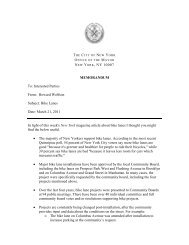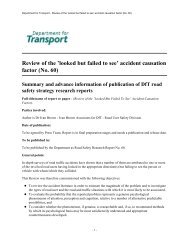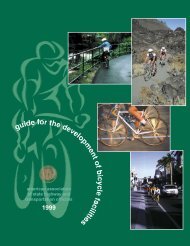Bicycle Reflector Project - Consumer Product Safety Commission
Bicycle Reflector Project - Consumer Product Safety Commission
Bicycle Reflector Project - Consumer Product Safety Commission
Create successful ePaper yourself
Turn your PDF publications into a flip-book with our unique Google optimized e-Paper software.
C. Test Subjects<br />
Forty-eight subjects (24 females and 24 males) between the ages of 25 and 44 years were<br />
selected to participate in the study. This age group was chosen because 51% of non-daylight<br />
bicycle and motor vehicle incidents involved motorists in this range. To analyze the effects of age<br />
on driving responses at night, the subjects were subgrouped into age groups of 25 to 34 and 35 to<br />
44 years. The subjects were assigned to specific test nights based on their age. Four of the eight<br />
test nights had subjects from 25 to 34 years, and the other nights had subjects from 35 to 44<br />
years. The mean age for each group was 29.5 years and 37.8 years, respectively.<br />
The subjects were provided by a contractor who screened the subjects for age, gender,<br />
valid driver's license, color blindness, and night blindness. Candidates who reported to be color<br />
blind, and/or had restrictions on driving at night were not supposed to be selected as subjects.<br />
The CPSC staff tested each subject's vision for near and far acuity, color, peripheral and contrast<br />
sensitivity under daylight and dark conditions.<br />
D. Process<br />
The testing occurred on eight days during period of October 22 - November 14, 1996.<br />
Six subjects were scheduled for testing on each night. The subjects' arrivals were at 1 hour 45<br />
minutes intervals with two subjects scheduled for each time period. The first subjects were<br />
scheduled to arrive at 7:00 p.m. Upon arrival, the subjects' consent forms were submitted, their<br />
driver's licenses were examined and their license number was recorded. The subjects were then<br />
given a vision screening exam and placed in a darkened room for 20 minutes to visually adapt for<br />
nighttime driving. During this time, the CPSC facilitator instructed the subject about the driving<br />
portion of the testing. The CPSC facilitator instructed the subject to say when s/he first saw and<br />
then recognized temporary roadside objects such as hazard indicators (safety cones), pedestrians,<br />
bicyclists, parked or standing vehicles, etc. The subject was told to keep talking and telling the<br />
facilitator what s/he is observing during the entire driving time.<br />
After the subject was dark adapted, s/he was seated in the driver's position of the test<br />
vehicle. The facilitator sat in the front passenger side and the data collection operator sat in the<br />
rear seat, behind the facilitator. Last minute reminder/instructions were given, and then the<br />
subject was directed to drive the car through the parking lot to the starting line. The 500 feet<br />
drive to the starting line allowed the subject to become familiar with the vehicle. After the<br />
facilitator received permission to proceed from the crew maintaining the bicycle targets, the<br />
subject drove at 20 - 25 mph through the course. As the subject reported object detection and<br />
recognition, the facilitator register distances traveled by pushing a remote button attached to the<br />
distance measuring instrument in the car. The subject's data were stored real time on a laptop<br />
computer.<br />
There was minimal vehicle traffic on the course. However, there were occasional<br />
encounters with other vehicles during a test drive. When these other vehicles were observed by<br />
the facilitator, the subject was advised to safely stop the car and let the other vehicle pass. If the<br />
other vehicle was coming toward the subject, the subject was told to safely stop the car and to not<br />
- 11 -





